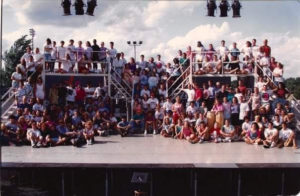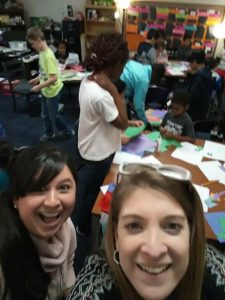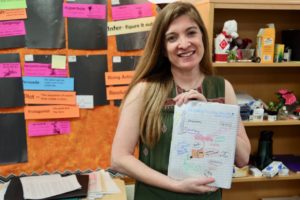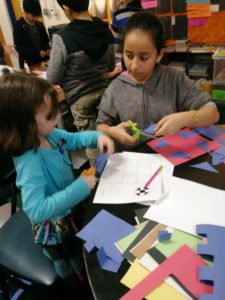Andy: What Our Students Need
It’s hard to describe Andy Marks-Garcia succinctly. She’s a world-traveler with deep Texas roots. A passionate educator who thought she would be a politician. A bilingual American whose second language (English) has supplanted her first (Spanish). She patrols her classroom with the authority of a mother and the enthusiasm of a child. Andy Garcia is a force of nature, and our students are better for it.
Even in the final weeks of school, Garcia’s classroom is awash with color. Some of the decorations are standard fare: motivational posters and instructional materials that have to be covered with pastel paper on test days. Most of the walls, however, are coated in student projects. Occasionally, her students’ educational art deco even spills into the hallways.
Thanks in large part to her unique journey toward Bellaire Elementary, Garcia represents a sort of new wave in education. She’ll be serving Bellaire and Stonegate Elementary as an Advanced Academic Specialist next year, and frequently leads workshops to help other teachers engage their students more effectively. Plenty of up-and-coming teachers use the same tools and techniques that she does, but it’s tough to imagine anyone replicating her frenetic-but-intentional style.
A style that encourages creativity and project-based learning, and therefore leans heavily on her treasure trove of school supplies.
There and Back Again
Garcia is a firm believer in educational variety. She’s glad to be on a staff that mixes former engineers and actors with lifelong educators. In her mind, varied experience means varied perspectives, which leads to a deeper understanding for students. In that regard, she has plenty to offer.

Garcia's Up with People cast comes together for a picture during their 1991-1992 tour. (Photo courtesy of Andy Garcia)
Now a fifth-grade teacher in the Hurst-Euless-Bedford Independent School District, Garcia spent multiple years on tour with the nonprofit educational performance group Up With People. She crossed the United States and toured Europe from 1991-1992, then helped to build new programs in her native state of Texas. With that trail blazed, she attended the University of Texas at Arlington and finished her degree in Amarillo before turning her eyes to the east coast.
After working at an ad agency and on multiple political campaigns in Washington, D.C., however, she returned home to launch a now-15-year-long career as an educator.
“I came back, decided I wanted to make a change, be an advocate… in a million years, I never thought I’d be a teacher. I thought I’d be a politician,” Garcia said. “I knew that if I was going to change things on the level that I thought they needed to be, I needed to come home to my roots.”
HEB ISD proved to be the perfect fit.
A Collision of Cultures
There’s a remarkable breadth of diversity in this district, with students representing 119 different nations and speaking upwards of 74 dialects at home. In the 60 years since its inception, the melting pot that is HEB ISD has shifted from a one-note condiment to a symphonic secret sauce; a sort of collective culture that has no singular roots. And, as much as that diversity ought to be celebrated, it comes with a host of challenges.

Garcia and Kindergarten teacher Monica Powers snap a selfie while their classes work on a collaborative Freedom Quilt project.
Some of our students have never known what it means to go hungry. Their parents have never felt the hollow ache of a budget sheet that just won’t balance. Some of our kids have had the strongest language skills in the family since their first years in school. More than half struggle to afford even the most basic school supplies. And yet, those challenges have a way of bringing people together.
“I think what really draws people to HEB is the different cultures,” Garcia said. “Every school is different and unique, but our whole goal is very much ‘what can we do for the students?’ and ‘how can our community get involved to help our students?’ Sometimes it’s like a second family.
“When you have the parent, the child, and the school all on board at the same time, you have that trifecta. Then when you add community support, it’s just that much deeper.”
Rather than grin and bear the pain of economic and cultural disconnects, Garcia — and, indeed, most of HEB ISD — looks for ways to meet children where they are. She’s brushed up on her Spanish, and makes a point to allow her students to teach the class new words in their own native tongues. For her, learning can’t be confined by a strict curriculum. It has to be organic. Inspiring. Fluid.
What Do Students Need?
In the course of our interview, Garcia confessed an unusual willingness to throw out a lesson plan at a moment’s notice. Most educators refine their courses with careful reflection at the end of the year. Garcia tosses methods out the moment they fail to produce results, often improvising interactive elements to serve the specific needs of each classroom. Sometimes, they need to draw diagrams and sketch their thoughts. Sometimes they just need to dance.
“I teach with an open mind,” she said. “If they are looking at me like, ‘huh?’ then I throw it out. We are going to start over. If that means I have to get up and do a jig with them, or I have to come up with a new dance or new move for them, I do it.
“You’ve got to get up, you’ve got to ignite it, and be excited about what you’re doing. You’ve got to believe in your students because when you stop believing, the student pulls back. But as soon as you earn that respect a student will love you no matter what you ask of them.”
A good portion of Garcia’s class revolves around creative projects. During our visit, students sketched out a Mystery plot with giant puzzle pieces and illustrated their own ideas and reactions to class readings. Garcia flipped, almost nonchalantly, through vibrantly decorated personal journals kept by her 10-year-old students. A “Freedom Quilt” hangs in the hall next to the Bellaire Library, lined with students’ reflections on the Civil Rights movement. Garcia’s class teamed up with a group of kindergarteners to bring that particular project to life.
Much like her peers, Garcia abandoned the idea of tracking classroom expenses years ago. There was no point in keeping a precise count if the tax exemption stopped at $250. But her estimation is that the average teacher spends $500-$1,000 in the first month of the school year. Some of those costs come from special projects. But most go right into supplies for at-risk kids.
Back 2 School, Ahead in Life
We built Operation Back 2 School for one reason: our friends at HEB ISD told us that they needed it. This year, we’ll provide 6,000 at-risk students with the supplies they need to be successful in class. That’s huge for them, psychologically and practically. It gives them confidence. Communicates their worth. Helps them do the work they have to do.
But Operation Back 2 School isn’t just about the kids.
It’s about the teachers who will pay hundreds, maybe even thousands of dollars for those kids if we don’t. The parents who need to know that someone wants their child to succeed as much as they do. A community that needs to see how strong it can be if everyone in it is willing to do the hard work of being a good neighbor. Believe it or not, a single day can do all of that.
“A kid needs to feel ready to go and very safe. If they don’t have school supplies we immediately need to start pedaling backwards because you never know what environment they’re coming from. You don’t know what happened the first thing in that morning. But if you can put a backpack on a kid full of supplies and they can walk into a room and be like, ‘Hey, I’m just like everybody else,’ it’s a whole different vibe that you're going to get,” Garcia said.
“These families are sometimes just as hungry to learn as our students are. I think that’s where 6 Stones has got it and the Church has got it. It’s not just about, ‘What do you believe in?’ and ‘What do you know?’ It’s about, ‘We are here to help you and love on you.’”


